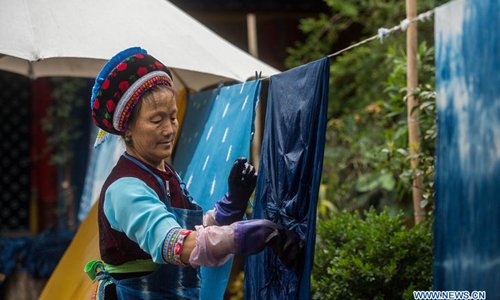
Dong Julan, a 60-year-old woman of Bai ethnic group, hangs the tie-dyeing cloth at Zhoucheng Village of Bai Autonomous Prefecture of Dali, southwest China's Yunnan Province, May 25, 2017. As a traditional folk technique of the Bai ethnic group, tie dyeing was listed in 2006 into state-level intangible cultural heritages. The technique goes through three major steps: making knots, dipping and dyeing, and drying in the sun. Traditional tie-dyeing products are mostly inspired by local scenery and based on blue and white colors. (Xinhua/Pu Chao)
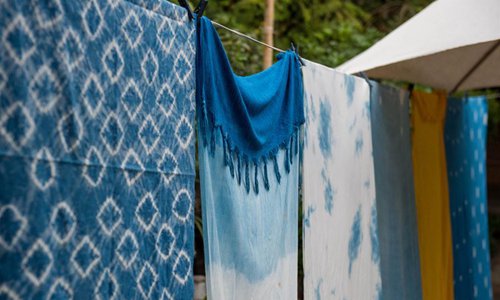
Photo taken on May 25, 2017 shows tie-dyeing cloth at Zhoucheng Village of Bai Autonomous Prefecture of Dali, southwest China's Yunnan Province. As a traditional folk technique of the Bai ethnic group, tie dyeing was listed in 2006 into state-level intangible cultural heritages. The technique goes through three major steps: making knots, dipping and dyeing, and drying in the sun. Traditional tie-dyeing products are mostly inspired by local scenery and based on blue and white colors. (Xinhua/Pu Chao)
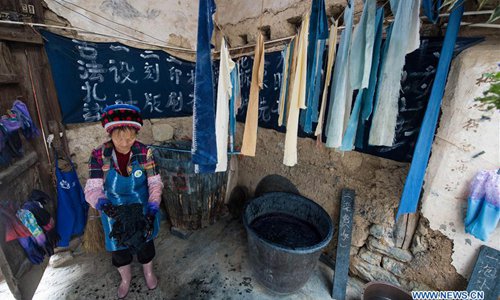
Dong Julan, a 60-year-old woman of Bai ethnic group, dyes the cloth of a tie-dyeing product at Zhoucheng Village of Bai Autonomous Prefecture of Dali, southwest China's Yunnan Province, May 25, 2017. As a traditional folk technique of the Bai ethnic group, tie dyeing was listed in 2006 into state-level intangible cultural heritages. The technique goes through three major steps: making knots, dipping and dyeing, and drying in the sun. Traditional tie-dyeing products are mostly inspired by local scenery and based on blue and white colors. (Xinhua/Pu Chao)
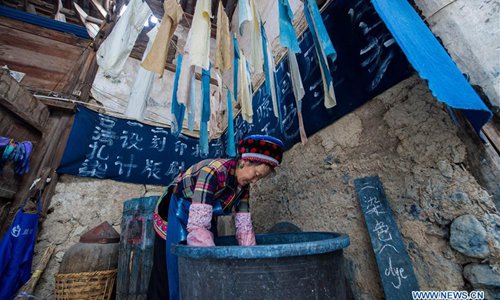
Dong Julan, a 60-year-old woman of Bai ethnic group, dyes the cloth of a tie-dyeing product at Zhoucheng Village of Bai Autonomous Prefecture of Dali, southwest China's Yunnan Province, May 25, 2017. As a traditional folk technique of the Bai ethnic group, tie dyeing was listed in 2006 into state-level intangible cultural heritages. The technique goes through three major steps: making knots, dipping and dyeing, and drying in the sun. Traditional tie-dyeing products are mostly inspired by local scenery and based on blue and white colors. (Xinhua/Pu Chao)
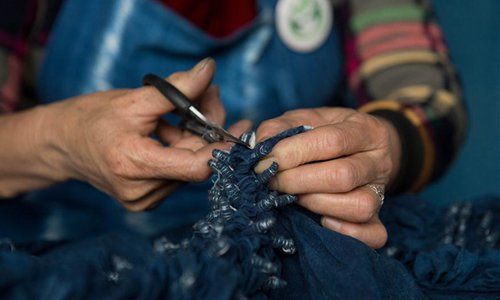
Dong Julan, a 60-year-old woman of Bai ethnic group, unties the knots of tie-dyeing cloth at Zhoucheng Village of Bai Autonomous Prefecture of Dali, southwest China's Yunnan Province, May 25, 2017. As a traditional folk technique of the Bai ethnic group, tie dyeing was listed in 2006 into state-level intangible cultural heritages. The technique goes through three major steps: making knots, dipping and dyeing, and drying in the sun. Traditional tie-dyeing products are mostly inspired by local scenery and based on blue and white colors. (Xinhua/Pu Chao)
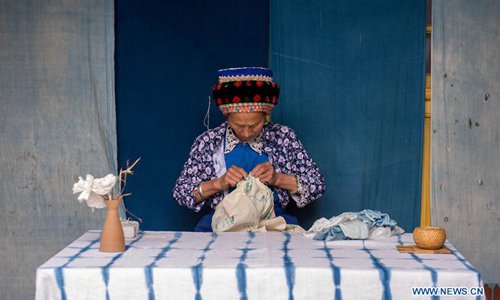
Su Jianhua, a 64-year-old woman of Bai ethnic group, makes tie-dyeing cloth at Zhoucheng Village of Bai Autonomous Prefecture of Dali, southwest China's Yunnan Province, May 25, 2017. As a traditional folk technique of the Bai ethnic group, tie dyeing was listed in 2006 into state-level intangible cultural heritages. The technique goes through three major steps: making knots, dipping and dyeing, and drying in the sun. Traditional tie-dyeing products are mostly inspired by local scenery and based on blue and white colors. (Xinhua/Pu Chao)
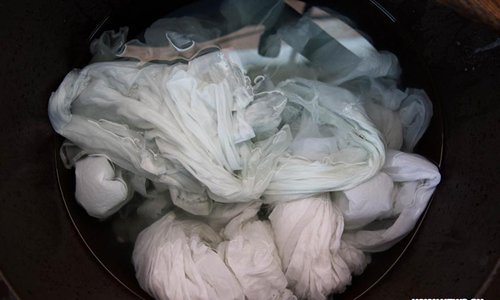
Photo taken on May 25, 2017 shows white cotton cloth used for making tie-dyeing products at Zhoucheng Village of Bai Autonomous Prefecture of Dali, southwest China's Yunnan Province. As a traditional folk technique of the Bai ethnic group, tie dyeing was listed in 2006 into state-level intangible cultural heritages. The technique goes through three major steps: making knots, dipping and dyeing, and drying in the sun. Traditional tie-dyeing products are mostly inspired by local scenery and based on blue and white colors. (Xinhua/Pu Chao)
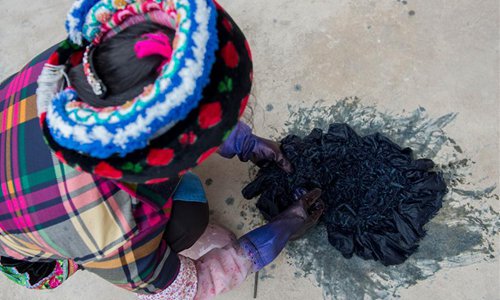
Dong Julan, a 60-year-old woman of Bai ethnic group, makes tie-dyeing cloth at Zhoucheng Village of Bai Autonomous Prefecture of Dali, southwest China's Yunnan Province, May 25, 2017. As a traditional folk technique of the Bai ethnic group, tie dyeing was listed in 2006 into state-level intangible cultural heritages. The technique goes through three major steps: making knots, dipping and dyeing, and drying in the sun. Traditional tie-dyeing products are mostly inspired by local scenery and based on blue and white colors. (Xinhua/Pu Chao)
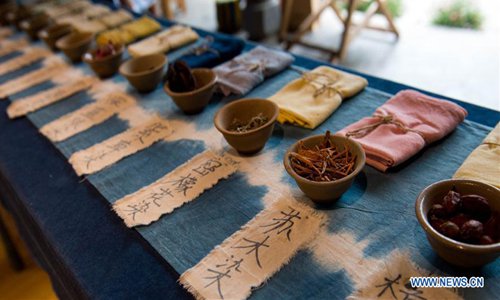
Photo taken on May 25, 2017 shows the dyestuff used for making tie-dyeing cloth at Zhoucheng Village of Bai Autonomous Prefecture of Dali, southwest China's Yunnan Province. As a traditional folk technique of the Bai ethnic group, tie dyeing was listed in 2006 into state-level intangible cultural heritages. The technique goes through three major steps: making knots, dipping and dyeing, and drying in the sun. Traditional tie-dyeing products are mostly inspired by local scenery and based on blue and white colors. (Xinhua/Pu Chao)
